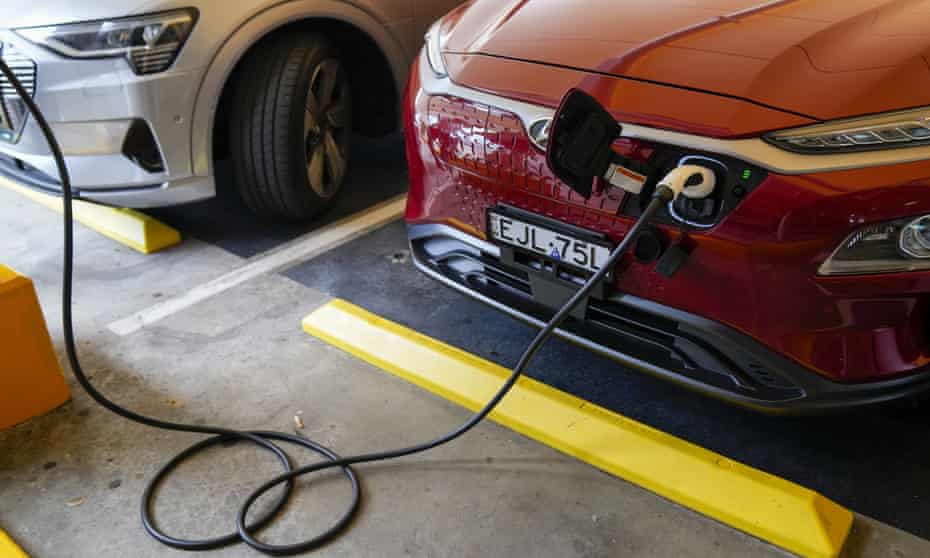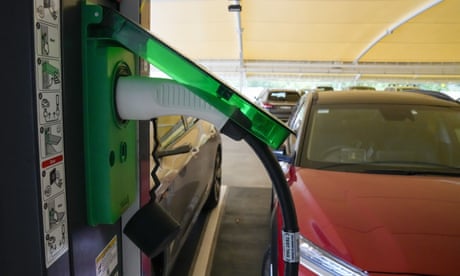Extract from The Guardian
The upfront price of a new EV is still high in Australia but incentives such as rebates and interest-free loans can help. We look at what’s on offer.

Over the next decade or so in Australia, making the decision to switch to buying an electric car will be more a question of when than if.
Last modified on Sat 13 Nov 2021 07.48 AEDT
Scott Morrison once claimed electric vehicles might end the weekend, but the prime minister changed his tune this week when he announced the Australian government’s new EV policy.
While the strategy may not actually do much to help get people into an electric vehicle, it’s the start of a shift as state and territory governments are already setting up incentives to get more people into EVs.
For many who might be looking to ditch their petrol or diesel car, the biggest roadblock remains the upfront cost of a new EV – though this is quickly changing.
What’s available and for how much?
Chinese carmaker BYD has plans to release a EV hatchback that will retail for $35k but among the brands currently on sale in Australia – Nissan, Renault, Tesla, BMW, Audi, Mercedes-Benz, Hyundai, Jaguar, MG, Mini – the most affordable are the MG ZS EV, at $44,990, and the Nissan Leaf, which retails for $53,190.

These are roughly the same price as the Harley Davidson LiveWire electric bike at $49,995 but a fraction of the $373,670 luxury Porsche Taycan Turbo S.
Those looking for a real bargain might try their hand in the secondhand market where it’s possible to pick up a second-hand Nissan Leaf for around $15,000 – though be sure to check the battery before buying as they become less efficient over time.
Why are they so expensive?
Unfortunately the choice of electric vehicle is still limited. Those living in the UK might be able to choose from over 130 models but Australians are limited to just 31 – a problem made worse with limited supply.
A recent CommBank survey found the number of people buying new cars in October had risen 31% compared with the same time last year, but consumers were finding it difficult to actually get hold of a new car.
Here in Australia the limited choice has been made worse by a lack of clear government policy that means global car makers just aren’t prioritising the country.
While companies such as Volkswagen expect to sell 400,000 electric vehicles this year, none will be in Australia, partly out of concerns proposals for a new EV user charge will put people off going electric.

For those who still can’t afford to pay the large upfront cost, some providers such as AGL are now offering subscription EV models that effectively allow people to rent an EV.
While the upfront cost of a new EV is steep, this expense is front-loaded over the lifetime of the vehicle. EV drivers obviously don’t need to pay for petrol, while repair costs are lower as electric cars require fewer parts.
When AGL calculated the difference using ABS statistics from 2019, they found the fuel bill on a petrol-driven car was $2,069 a year while the cost of charging an EV stood at $723.
These numbers can vary by state depending on the cost of electricity, the price of petrol and a person’s access to rooftop solar at home, which remains the cheapest way to recharge.
What help can I get?
To help with the high upfront costs, states and territories are introducing incentives to help, even if no two states are created equal.
A close second are drivers in the ACT, who will pay no stamp duty or registration for two years, while the territory government is offering $15,000 interest-free loans on new purchases.
South Australia and Victoria are offering similar $3,000 rebates to those in New South Wales, while waivers on stamp duty and registration fees are available to drivers in Tasmania and South Australia respectively.
Western Australia, Queensland, Tasmania and Northern Territory currently offer no direct purchase incentives, but each state except WA offers waivers or discounts on registration or stamp duty.
Where can I recharge?
Charging an EV requires a plug-in cable, though the basic equipment that comes with most models will typically take around eight-to-12 hours to fill a battery, meaning that many drivers opt to install a fast-charging station at home.
Set-up costs for these systems will add to the initial purchase cost, though there are dedicated companies like JET Charge that can handle home installations.
Those caught out while on the road can access a growing network of fast-charging stations from companies like ChargeFox. Their stations can add 400kms of range in 15 minutes and can be found using their app.
New
South Wales and South Australia have plans to introduce a charge but
have said they will delay its introduction until 2027 to get electric
vehicles off the ground in Australia, but Victoria has already begun
collecting its user charge as of 1 July this year.
As other
countries such as Norway are already planning to end the sale of petrol
vehicles as early as 2025, similar bans will eventually be picked up
elsewhere over the next decade or so, making the decision to switch more
a question of when than if.
No comments:
Post a Comment